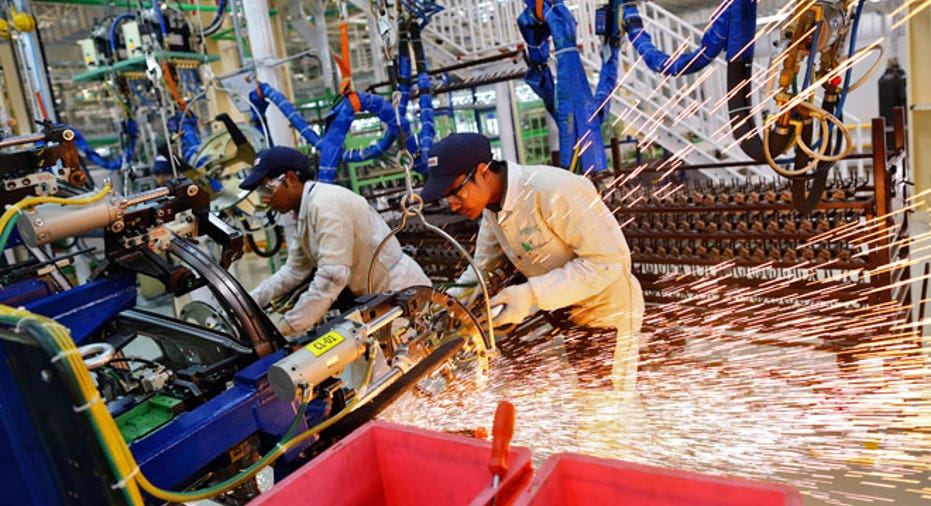It’s Not Just Consumers Getting Pinched by Higher Prices

If you’ve visited the grocery store, be it a Kroger (NYSE:KR) or Whole Foods Market (NASDAQ:WFM), odds are you’ve noticed the pinch of higher prices and your hard earned dollars buying less.
We’ve seen several pronounced moves higher when it comes to food, including the protein complex that includes beef, pork and shrimp as well as other commodities like coffee, cocoa, and dairy. Those moves led companies like McDonald’s (NYSE:MCD), Sonic Corp. (NASDAQ:SONC), Chipotle Mexican Grill (NYSE:CMG) and more recently Starbucks (NASDAQ:SBUX) to raise prices. It’s either that or absorb the price increases, which means either letting it hit their profits or trim back other areas, such as research & development, capital spending, or hiring.
Factor in more states raising the minimum wage, and as Angie Pappas, director of communications for the California Restaurant Association, told Nation’s Restaurant News: “Operators will tell you they’ll do everything possible not to raise prices because they see the effect that has on traffic. But we will see prices go up as a result.”
Restaurants are not alone in hiking their prices recently. Kraft Foods (NASDAQ:KRFT) recently put in place higher coffee prices for its Maxwell House and Yuban coffee brands as did the J.M. Smucker Company (NYSE:SJM) that owns the Folgers coffee brand. That’s the second price increase in recent weeks for Kraft, which also boosted prices on almost half of its portfolio, including cheese and meat products. Was Kraft alone? It was not as the soon-to-be acquired Hillshire Brands (NYSE:HSH) raised prices on its Jimmy Dean sausage and Ball Park hot dogs as pork prices have climbed on a year-over-year basis.
Even the average consumer has watched the steady move higher in gasoline prices, and AAA is calling for the highest prices at the pump since 2008. Gasoline prices are averaging $3.68 a gallon nationwide, which is about 20 cents higher than the same period last year.
Is it any wonder we saw a tick up in the May consumer prices, while consumer spending and retail sales data have been disappointing of late?
While many are focused, and rightly so, on what this means for the consumer, we’ve started to see a sharp rise in input prices buried inside more than a few industrial and manufacturing reports. From China and Japan to the U.S. and even the eurozone with its slower rate of expansion, all of the June Markit and HSBC PMI readings noted a month-over-month increase in input prices. In the U.S. specifically, Markit’s PMI reports have noted input prices have been rising and an increasingly swift pace.
Even in the Institute for Supply Management’s monthly manufacturing data, prices have been increasing over the last few months. Inputs that are behind those higher prices include aluminum, tin, zinc, platinum, steel bar, chemicals, plastic products and other petroleum-based products.
Commentary inside the ISM report points to tight supply in several industries and when coupled with higher input costs means the odds of price increases coming are high. Already in the eurozone, Markit Economics is reporting that in June, “manufacturers raised their average selling prices for the second month in a row.”
These reports are the latest sign that inflation is spreading beyond food and energy and into the industrial and manufacturing industries. Just as it took a few months to rear its head in the Consumer Price index, these increases will likely be felt in the Producer Price Index before too long. When this happens, it will re-ignite timing concerns as to when the Federal Reserve will start to move interest rates higher. That could weigh not only on bonds, but also on housing as well in the back half of 2014 and into 2015. Higher interest-rate expectations are bound to flow through to mortgage rates, which would make housing even less affordable for the increasingly cash-strapped consumer.
Now there are those that say some inflation is good for the economy. True enough, but the risk is inflation breaking out higher and faster than is currently expected by the stock market and the Fed. Remember too that so far in 2014, the Fed hasn’t exactly been spot on in calling the economy.
Once again it seems that just when the economy looks like things might take off, factors – in this case inflation and subsequent interest rate hikes – could take the wind out of the economic sails.
Chris Versace has no positions in any companies mentioned, nor does the Thematic Growth Portfolio that he manages.